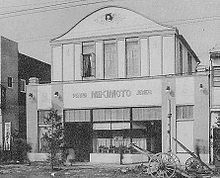- Mikimoto Kōkichi
-
Mikimoto Kōkichi (御木本 幸吉, 25 January 1858 – 21 September 1954) was a Japanese entrepreneur and adopter of the Mise/Nishikawa technique for production of synthetic cultured pearls.
Contents
Early life
Born as the first son of an udon shop owner in Toba, Shima Province (present-day Mie prefecture), Mikimoto left school at the age of 13 and sold vegetables to support his family. Seeing the pearl divers of Ise unloading their treasures at the shore in his childhood started his fascination with pearls.
Meiji entrepreneur
In 1888, Mikimoto obtained a loan to start his first pearl oyster farm at the Shinmei inlet on Ago Bay in Mie prefecture with his wife and partner Ume. On 11 July 1893, after many failures and near bankruptcy, he was able to create the hemispherical cultured pearls. He introduced these mabes at a marine products exposition in Norway in 1897 and began an export business. However, it took him another 12 years to create completely spherical pearls that were indistinguishable from the highest quality natural ones, and commercially viable harvests were not obtained until the 1920s.
Mikimoto did not know that government biologist Tokishi Nishikawa and a carpenter, Tatsuhei Mise, had each spent time in Australia and learned the secret to spherical pearl production from expatriate British marine biologist William Saville-Kent — inserting a piece of oyster epithelial membrane (the lip of mantle tissue) with a nucleus of shell or metal into an oyster's body or mantle causes the tissue to form a pearl sack. The sack produces nacre, which coats the nucleus, thus creating a pearl. Mise received a 1907 patent for this grafting needle. When Nishikawa applied in the same year, he realized that Mise had already secured a patent. In a compromise, the pair agreed to cooperate, calling their discovery the "Mise-Nishikawa method".
Mikimoto had received a patent in 1896 for producing hemispherical pearls, or mabes, and a 1908 patent for culturing in mantle tissue, but he could not use the Mise-Nishikawa method without invalidating his own patents. Mikimoto then altered his patent application to cover a technique to make round pearls in mantle tissue, which was granted in 1916. However, this method was not commercially viable. Mikimoto finally made arrangements to use Nishikawa's methods after 1916, and Mikimoto's business began to expand rapidly.
Industry success
The new technology enabled Japan's cultured pearl industry to quickly expand after 1916; by 1935 there were 350 pearl farms in Japan producing 10 million cultured pearls annually.
By 1935 the Japanese pearl industry was facing oversupply issues and plummeting prices for Japanese cultured pearls. Mikimoto promoted Japanese pearls in Europe and the USA to counteract falling prices. He publicly burnt tons of low-quality pearls as a publicity stunt to establish a reputation that the Mikimoto company only sold high-quality cultured pearls.
In 1899, the first Mikimoto pearl shop opened in the fashionable Ginza district of Tokyo selling natural seed pearls and half round pearls. The Mikimoto business expanded internationally, opening stores in London (1913).
After World War II Mikimoto opened in Paris, New York, Chicago, Boston, Los Angeles, San Francisco, Shanghai and Bombay, and was thus one of the first Japanese brands to attain an international presence and recognition.
Mikimoto had to constantly fight allegations that his pearls were only “imitations” of real pearls, despite scientific reports to the contrary. Mikimoto took advantage of every opportunity to personally promote his pearls, and took part in the 1926 Philadelphia World Exposition in which he displayed a replica of the "Liberty Bell" covered with pearls.
Mikimoto was the official jeweler of the Miss USA (2003–2008), Miss Universe (2002–2007) and Miss Teen USA (2001–2008) pageants, under the Miss Universe Organization.
Personal
Just before his death, Mikimoto was awarded the Order of Merit (First Class) by the Japanese government.
On 21 September 1954, Mikimoto Kōkichi died at age 96. He was posthumously awarded the Grand Cordon of the Order of the Sacred Treasure.[1]
See also
- Mikimoto Pearl Island - Mikimoto Kōkichi's Memorial Hall is in this island.
References
External links
- K. Mikimoto & Co., Ltd. - Official website
- Mikimoto Pearl Island
- History of Kōkichi Mikimoto on their American Website
Purveyors to the Russian Imperial Family Ararat · Breguet · Chichelev · Chopard · Cristal · F. Meltzer & Co. · Farina gegenüber · Franck Muller · Gus-Khrustalny Crystal Factory · House of Fabergé · Imperial Porcelain Factory · Khlebnikov · Mikimoto Kōkichi · Ovchinnikov · Patek Philippe & Co. · Sazikoff · Shustov & Sons · Smirnoff · Steinway & Sons · Stepan Razin Brewery · Tiffany & Co.

 CategoryCategories:
CategoryCategories:- Purveyors to the Russian imperial family
- 1858 births
- 1954 deaths
- Japanese businesspeople
- Japanese inventors
- Japanese scientists
- Pearls
- People from Mie Prefecture
Wikimedia Foundation. 2010.



